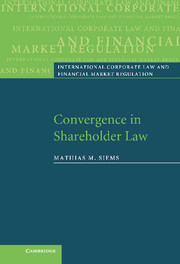Book contents
- Frontmatter
- Contents
- Preface and acknowledgments
- List of abbreviations
- Table of cases
- Table of legislation
- Introduction
- PART I The object and course of the investigation
- PART II The status quo of convergence
- 2 Legal bases
- 3 Bases for a shareholder typology
- 4 The ‘shareholder as such’
- 5 The shareholder in the power structure of the company
- 6 Conclusions to Part II
- PART III Developmental trends and patterns
- PART IV Conclusion
- References
- Index
3 - Bases for a shareholder typology
Published online by Cambridge University Press: 15 December 2009
- Frontmatter
- Contents
- Preface and acknowledgments
- List of abbreviations
- Table of cases
- Table of legislation
- Introduction
- PART I The object and course of the investigation
- PART II The status quo of convergence
- 2 Legal bases
- 3 Bases for a shareholder typology
- 4 The ‘shareholder as such’
- 5 The shareholder in the power structure of the company
- 6 Conclusions to Part II
- PART III Developmental trends and patterns
- PART IV Conclusion
- References
- Index
Summary
It is not possible to consider all the details of the shareholder law of the various legal systems under review. Accordingly, proceeding in principled fashion, I will start with a consideration of what ‘type’ of shareholder the law focuses on. Using this methodology, I will then determine how the typical features of the shareholder's position have been reflected in the laws of the UK, the US, Germany, France, Japan and China (Chs. 5, 6).
The shareholder in the theoretical debate
Many approaches to classifying the shareholder into types can be found in the literature. One particularly exhaustive subdivision comes from Jennifer Hill, who distinguishes the shareholder as ‘owner/principal’, as ‘beneficiary’, as ‘bystander’, as ‘participant in a political entity’, as ‘investor’, as ‘cerberus’ and as ‘managerial partner’. Whether all these divisions can be applied to all countries could be doubted. In Bernhard Groϐfeld's words, the risk might be that we are looking at a foreign system through the spectacles of our own experience of the world, our language and our linguistic understanding. The subdivision below makes it clear, however, that in the present context there are internationally similar models for explaining the shareholder's position.
The shareholder as ‘owner’ or ‘quasi-partner’
In olden times particularly, but still today too, the terminology of the shareholder as owner of the company was and is widely used. There are many examples of this in the literature, in court decisions, in best-practice guidelines, and in legislative materials.
- Type
- Chapter
- Information
- Convergence in Shareholder Law , pp. 60 - 67Publisher: Cambridge University PressPrint publication year: 2007

